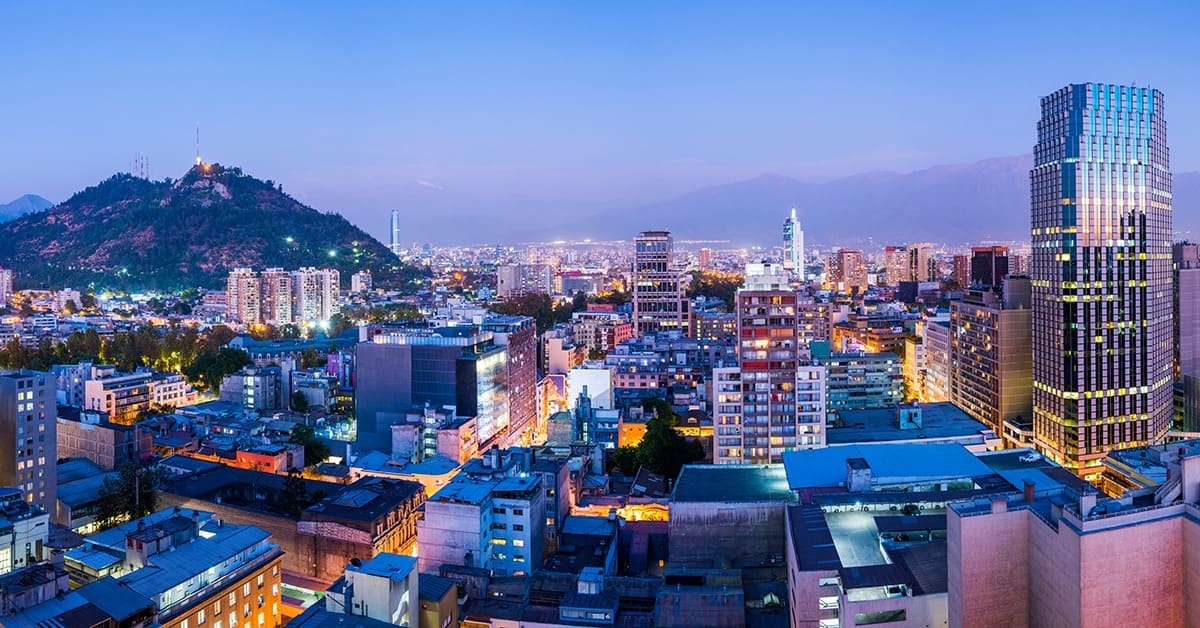The country seeks increased investment after an expected short economic contraction.

|
VITAL STATISTICS |
|---|
|
Location: South America |
|
Neighbors: Peru, Bolivia, Argentina |
|
Capital city: Santiago |
|
Population (2022): 19.6 million |
|
GDP per capita (2022): $15,550 |
|
GDP Growth (2022): 2.4% |
|
Inflation (2022): 11.6% |
|
Unemployment rate (2022): 7.8% |
|
Currency: Chilean peso |
|
Base interest rate: 10.25% |
|
Corruption Perceptions Index rank (2022): 27/180 |
|
Investment Promotion Agency: InvestChile |
|
Available investment incentives: Law to accelerate the development of the country’s extreme north and south and includes tax credits and subsidies for hiring workers residing in those regions; tax benefit for investment in research and development; VAT exemptions on imports of capital goods and on export services; selected entrepreneurs provided with grants to develop a startup; free trade zones |
|
Political Risks: High economic inequality has sparked civil unrest; strong majority of the public favors a new constitution; territorial disputes with neighbors |
|
Security Risks: Problems with cocaine transshipment and money laundering; theft and petty crime; sometimes violent protests, including arson and small-scale bombings; frequent demonstrations and strikes; harassment and verbal abuse of women traveling alone; dangerous roads in mountains |
|
PROS |
|
Pro-business environment |
|
Stable democracy |
|
A strong sovereign bond rating for Latin America |
|
Strong macroeconomic fundamentals |
|
Sound legal framework |
|
General respect for private property rights |
|
Equal rights for foreign and domestic companies |
|
Free flow of capital and profits for foreign companies |
|
Vast natural resources |
|
Enterprises may be 100% foreign owned except in strategic sectors |
|
Low corruption |
|
CONS |
|
Uncertainty about new constitution |
|
Expected short-term economic contraction |
|
High real interest rates |
|
Growing governmental debt |
|
Has not fully complied with intellectual property obligations in US-Chile FTA |
|
Large-project approvals cumbersome, time consuming, and unpredictable |
Once regarded as the Switzerland of South America due to its high living standard and breathtaking mountain ranges, Chile underwent a profound shift in its economic dynamics over the last decade.
Although the Andean country’s broad economic matrix diversified well beyond the copper exports that had carried its GDP for decades, a growing population and mounting government debt led to increased social tension in a nation accustomed to high social welfare spending.
“The Chilean economy has had several large impact factors to consider,” says Todd Huckaby, co-founder of Chile-based boutique investment company Hudson Bankers. “[These] began shortly before Covid-19, with a public uprising demanding social improvements and a more egalitarian relationship among all classes of citizens.”
During and since the pandemic, the need for greater social assistance weighed on the peso. But while debt rose, the debt to GDP ratio held pretty steady—as it has since 2008. The global commodities supercycle and strong fundamentals brought surging profits to the country’s metals and energy sectors, which are now investing heavily in modernizing.
The country has presented investors for decades with some of the best business conditions in South America. According to Banco de Chile officials, foreign investment represents around 75% of the annual Chilean GDP.
That doesn’t come for no reason. Chile’s flagship foreign investment law guarantees equality between foreign and local investors and lets foreign investors repatriate capital and send back their profits. On top of that, the country’s 32 free trade agreements (FTAs) with 66 countries—including the US, Canada, China, Brazil and the EU—enhance market access, reduce tariffs, and boost trade. At the same time, special economic zones provide targeted incentives for strategic growth.
“These facilities are why Chile is one of the best options for foreign investment relative to other countries in Latin America,” says Huckaby, adding praise for Chile’s “low corruption levels and great economic freedom.”
The main risks for business originate in politics. The government is pressured to keep social spending high, with consequences for debt and currency. However, the left-wing President Gabriel Boric, who assumed office in March 2022, has shown an ability to balance those demands with a more business-focused agenda. Boric’s government has maintained a prudent fiscal policy, not increasing debt levels.
As Chile aims to establish itself as one of South America’s fastest-moving economies, opportunities inside and outside the traditional commodities spectrum are emerging for foreign businesses.
Chile GDP Growth After Contraction
In the near-term, however, Chile will have to endure a transition period of short-term economic pain. “Restoring a higher sustainable GDP expansion is one of the, if not the most, important challenges for the country,” says Rodrigo Aravena, chief economist at Banco de Chile. “We must also address all the increasing economic, social and political demands from the middle-income trap that we currently face.”
The 6.5% inflation rate, which continues to drop, is eroding real wages, dampening consumer sentiment. Furthermore, economic uncertainty has led to a contraction in investment. GDP dropped by 2.3% year over year in the fourth quarter of 2022 and another 0.6% in the subsequent quarter.
The cooling of the post-pandemic commodities supercycle was another headwind for Chile, due to its persistent high reliance on exports. Copper exports comprise almost 10% of Chilean GDP, Huckaby explains. Copper hit an all-time high in early 2022, then fell back by almost 25% as of mid-2023.
The Central Bank of Chile pivoted with a rate cut of one percentage point in July, bringing the benchmark interest rate to 10.25%. Still, with the real rate at 3.75%, implying tighter financial conditions than in most of South America—except for Brazil—the analyst consensus expects the country’s economy to contract through the rest of the year while others await a second-half rebound.
On the bright side, the recent rate cuts have prompted the country’s central bank to improve its fiscal year GDP projection to between -0.5% and +0.5%, from an initially daunting outlook of -1.75% drop.
But the perspective looks much brighter, with inflation projected to converge toward the medium-term target of 3% in 2024.
“The Chilean GDP will likely post a slight decrease this year and an expansion of around 2% next year,” says Aravena. And if this is half the growth rates Chile posted 10 years ago, he continues, “still, Chile has been one of the most successful emerging countries in recent decades, demonstrating great resilience in global crisis, with softer recessions and faster recoveries.”
The promise of sounder fiscal management, including tax reform proposed by President Boric, is likely to improve the government account balance over time.
The other midterm tailwind for Chile’s GDP is an expected rebound in copper prices due to increasing activity in China—the primary buyer of the country’s top export.
Huckaby says recent research suggests copper prices should rise again in the second half of 2024 into 2025, which would give Chile a boost. “The governmental initiative to promote Chinese technological manufacturers will rely on copper for their manufacturing processes, increasing demand and ultimately putting upward pressure on price,” he adds.
Investment Opportunities In Chile
While Chile’s internal problems may hinder faster economic growth, the country is not short of opportunities for investors looking into the Andean nation. “Chile has structural advantages in several sectors. Some include natural resources, given its abundance and competitive conditions,” explains Aravena.
Besides Chile’s immense copper reserves, the renewable-energy sector has been booming, with multinational giants such as Italy-based Enel and Spain’s Iberdrola pouring massive sums of cash into the country.
These companies have been looking into Chile’s potential in the solar, wind and green hydrogen industries, with the country presenting some of the best natural conditions in the world. “Companies investing in Chile can leverage this comparative advantage to produce a certain amount of energy at the lowest levelized cost of energy possible, in a country where the energy system is fully dollarized,” adds Huckaby.
He adds that the domestic green hydrogen industry is projected to reach $35 billion by 2050, presenting tremendous opportunities for investors looking to invest in the sector now.
Along with the world’s largest copper reserve, Chile also has the world’s largest natural lithium reserve, which has captured significant attention from the largest electric-vehicle (EV) companies in the world. Recently, Tesla executives met with Chilean authorities, including the ministers of foreign affairs and mining, to discuss possible collaborations.
Chinese EV leader BYD, as well as companies such as Australia’s Lithium Power International and Canada’s Wealth Minerals, will become fully operational in the country over the next couple of years. Moreover, US-based lithium producer Albemarle has been in business in the country for more than 40 years and is planning to expand.
However, as Huckaby points out, regulation remains challenging for the lithium mining industry. “Despite regulatory difficulties, we see there are many opportunities in the sector,” he says, adding, “The global demand for lithium is expected to almost quadruple from 2023 to 2030, meaning that supply will need to be met and exploration is necessary.”
According to data from Hudson Bankers, Chile has also shown remarkable improvement in the agricultural sector, leading to double-digit growth over the past decade. “Chile’s abundance of natural resources gives the agricultural sector a significant upper hand, especially due to the availability of water and land in the central and southern regions,” adds Huckaby.
Moreover, the country has been investing heavily in innovation, aiming to expand its economic matrix beyond commodities, notes Banco de Chile’s Aravena. “We have also recently seen important entrepreneurship in the country, including several globally recognized startups, receiving important attention from the investor community,” he adds.



